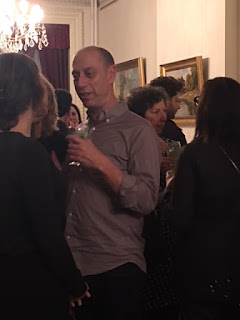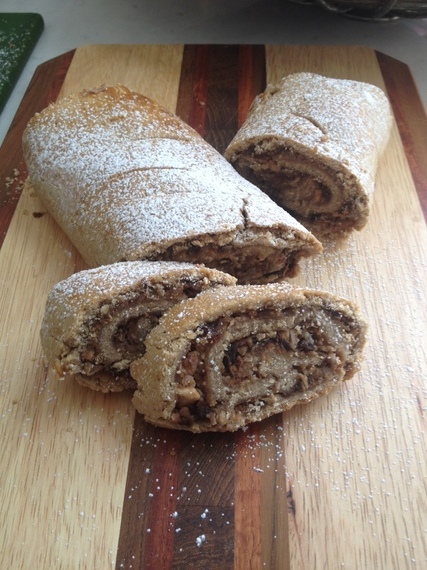A tagine pan, a hand-crank meat grinder, and borscht…all rather pedestrian things, but to some of the storytellers at “Village Schmaltzy” these evoke a storehouse of memories. Memories of eras and people, now long gone, but still impactful enough to counsel and advise from the beyond. The stories have embedded themselves into lives like a sign left by a signet ring on a dollop of hot wax that was dripped onto the flap of an envelope. These memories left their mark, and on a misty, drizzly evening in New York City, they flooded the room and enveloped us as a group of people who work with food, write about food, and just love food, listened and related them to the stories in our own heads.
One of the pleasures of working from home is that on days that are chilly, damp, and grey, you can huddle in your home office and thank your stars that you don’t have to venture out into the wilds. And so it was for me a few nights ago, until I remembered that I had purchased a ticket to “Schmaltzy.” How could I pass up an event sponsored by The Jewish Food Society, an organization that wants to preserve Jewish heritage through food and bills this event as being “kind of like the Moth, but with knishes?”
 |
| David Lebovitz |
It was more than appropriate that this foodie event was held in a Greenwich Village brownstone known as the Salmagundi Club — the name salmagundi being attributed to a stew that was served to the many artists and students who were members back in the late 1800s. We were a group of about 50, drinking our “Schmaltzy Cocktails" in a grand room in this very regal Italianate-style building, standing very close together, amidst walls that were covered with paintings. And there, out of the corner of my eye, I spied David Lebovitz. He was not a speaker, but like me, a listener and an eater. When you work with food, you never tire of hearing about.
How could I pass up an event sponsored by The Jewish Food Society that bills itself as being “kind of like the Moth, but with knishes?”
We were promised five dishes and five stories from Greenwich Village residents for whom food is life, with the stories being the “amuse bouche” of the evening. The wonderful appetizer was most definitely the iconic New York Times restaurant critic, Mimi Sheraton. The diminutive Ms Sheraton (I don’t know why I expected her to be “bigger”) regaled us with her memories of her days living on 12th Street amongst other culinary notables like Madhur Jaffrey and James Beard. “Most everything is celebrated or mourned over a meal,” she said, adding that when her mother would hear of a death in the family, her response was usually, “I’ll call the butcher.” Her remembrance of cold borscht on a hot day, when she announced to her parents that she was going to marry Clark Gable (she was eight at the time) was priceless, and the vision of the pink borscht splashing out of the bowl when her disapproving father banged on table brought back memories similar to the “loud” meals in my own parents’ home.
 |
| Mimi Sheraton |
I don’t believe that the featured chefs and restaurateurs were truly writers by trade, but as they spoke of the people in their lives who served as teachers and mentors, they waxed poetic. Their words came alive with color and texture and emotion. It’s ironic that those who had the biggest influence on them were not famous by any stretch of the imagination—they were not celebrity chefs—they were family—mothers and grandmothers. Old school educators who taught them by doing and infused their lives, not just with sugar and spice, but with love and care. These speakers came from all areas of the globe—from Israel to Brooklyn, and their teachers came from such vastly different places as Russia and Egypt and Morocco, but the essence of their experiences were similar enough they may well have all grown up on the same street.
 |
| Clove Rugelach from Zucker Bakery |
Following the heartfelt stories came the fruits of their labor. From Nir Mesika, who cooked shakshuka for everyone at his grandmother’s shiva, we had her Egyptian Sofrito, a hearty short rib and potato stew. Stacey Harwood-Lehman brought her Kasha Varnishkas, glistening with fat and studded with onions and mushrooms. Ed Schoenfeld brought his crackling, crisp Pastrami Eggrolls. Zohar Zohar, who said people love her bakery because it smells like home, brought her chocolate striped Clove Rugelach, and Marissa Lippert brought her grandmother Bebe’s Apple Kuchen. Each dish brought to the event its own flavor and story, but could it be possible that because we knew the story, the flavor was even more heightened? Could it have been that because each bite carried with it a tradition and history that spanned miles and generations that the food tasted even better? Do we appreciate food more when we can almost feel all the symbolic hands that created it? Absolutely! The food we feasted on at “Schmaltzy” was anything but—it was magical. A rainy night did not stand a chance against all that.
 |
| Nir Mesika of Timna Restaurant |






